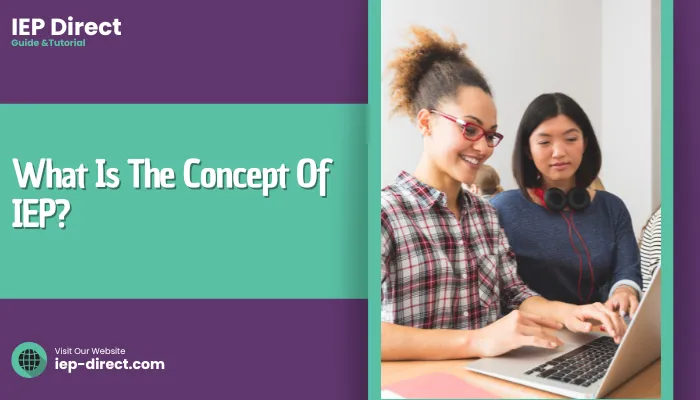I have you ever thought of What Is The Concept Of IEP Direct? no? don’t worry I got you, you see IEP, or Individualized Education Program, is a tailor-made plan that encompasses the unique educational requirements of a child with disabilities.
This document establishes appropriate goals, services, and accommodations to help the child succeed in school. For parents and educators, understanding IEPs lays the grounds for their intervention on behalf of the students so that they can receive proper support.
In this blog we will discuss deeply so let’s dive in

What Is The Concept Of IEP? Let’s Find Out
Now we are in the important part of What Is The Concept Of IEP, from here onward we will get to know everything about behind the scene and how it’s works.
Individualized Education Program (IEP), on the other hand, is a personalized plan designed to address specific educational needs concerning children with disabilities. It serves as a legal document that specifies the targets while also including relevant services for enhancing learning at schools.
Think about it as an individual GPS for your education.
The Purpose of an IEP
The main objective of this program is enabling children with disabilities to reach their full potential by providing them with appropriate education and support. It seeks to establish an enabling learning environment where every child can prosper.
There main key purpose has been listed below
Key purposes of an IEP
- Tailored education: Gives precise teaching and aid for individual needs.
- Measurable goals: Shows areas where improvements must be tracked.
- Collaboration: Fosters teamwork between parents, educators, and the child.
- Legal protection: Guarantees the child’s right to a Free and Appropriate Public Education (FAPE).
Therefore, these are the purposes, and they stand by their value firmly, so there is no need to worry. They help you in every aspect.
IEP Child Education Plan
IEP breaks down a what is the concept of IEP which is child’s education into tiny pieces. It sets specific goals, proposes services, and recommends necessary accommodations that will ensure the success of any child at school. But what exactly does an IEP package contain?
Let us review its main components.
Current Performance Levels (PLAAFP)
In order to begin developing an individualized education program for a student, one needs to assess his/her current performance levels first. Generally speaking, this stage is termed Present Levels of Academic Achievement and Functional Performance (PLAAFP).
This snapshot shows where the child excels in school and where he may need assistance or accommodation for his disability which will lead to What Is The Concept Of IEP.
Lets’ see what is included.
What Is Involved In PLAAFP?
Understanding what is involved in PLAAFP is crucial for creating effective IEPs.
Below you can get what is included:
- Academic abilities (math, writing, and reading skills)
- Behavioral patterns
- Emotional and social development
- Communication skills
- Physical growth
- How much disability affects the child’s involvement in general education
Therefore, PLAAFP highlights key areas impacted by disability, guiding tailored educational plans for each child’s success.
Yearly Goals
Depending on PLAAFP, the IEP team sets up some specific, measurable, achievable, and realistic goals for the child. These goals outline what the child would be expected to achieve within a year.
Let’s see their goal.
Key Characteristics Of Effective IEP Goals:
Setting effective IEP goals is essential for supporting a child’s educational development. These goals must be:
- Specific: Clear and focused on a particular skill.
- Measurable: Includes criteria for deciding if the goal has been achieved.
- Achievable: Possible to do within a one-year period.
- Relevant: In line with the needs of the child as well as his or her future aspirations.
- Time-bound: Specifies when the objective will be achieved by.
Therefore, Effective IEP goals provide a structured roadmap for a child’s learning journey. They help educators and parents measure progress and ensure the child’s needs and aspirations are met within a set period.
Special Education And Related Services
Special education entails specially designed instruction aimed at meeting the unique needs of a child. Related services are other forms of support that help students benefit from special education.
Some of them include:
- Speech therapy
- Occupational therapy
- Physical therapy
- Counseling
- Assistive technology
- Transportation
Special education and related services provide essential support tailored to each child’s unique needs.
Main Components Of An IEP
Parents and educators need to understand the key components of an IEP so that they can advocate effectively for their kids’ needs. The two partners can develop an IEP that sets the stage for a successful education.
Remember: An IEP is a dynamic document that should be reviewed and updated regularly to ensure What Is The Concept Of IEP continues to meet the child’s evolving needs.
Meet The IEP Team
An Individualized Education Program (IEP) is a collaborative effort involving several key players. Each member brings unique perspectives and expertise to the table to create a comprehensive plan for a child with a disability.
Parents
Parents are the cornerstone of the IEP team. They know their child best and provide invaluable insights into their strengths, challenges, and preferences.
Parental roles in the IEP process:
Parents are pivotal in the IEP process, offering crucial insights into their child’s strengths and needs.
- Sharing information about their child’s development and needs.
- Collaborating with educators on appropriate goals and services.
- Advocating for their children’s rights and needs.
- Consulting regarding the progress made by them at school or home support strategies.
Therefore, By sharing information, collaborating with educators, advocating for their child’s rights, and consulting on progress, they ensure effective support and successful outcomes.
Teachers
General education teachers work closely with special education teachers to understand what areas students excel or find difficult while in classrooms before participating appropriately in developing learning objectives and interventions that match these areas.
Teacher roles in the IEP process
Teachers play a vital role in the IEP process, collaborating with team members and parents to develop and implement effective goals.
- Work with team members and parents to develop IEP goals.
- Make necessary adjustments and implement IEP in the classroom.
- Monitor student progress and feedback to the team.
Therefore, By working closely with the IEP team, making necessary classroom adjustments, and monitoring student progress, teachers help ensure that IEP goals are met and that each student receives the support.
Professionals on Special Education
Speech therapists, occupational therapists, special education teachers, and other professionals assist students with disabilities.
Here are some roles which will help you.
Different roles of special education professionals
Special education professionals play crucial roles, from conducting evaluations for eligibility to providing specific instructions and assistance.
- Do evaluations for special education eligibility purposes
- Provide specific instructions and assistance to the child
- Collaborate with the school’s IEP team on developing and implementing the child’s IEP
- Offer expertise and guidance on particular impairments or accommodations required
By leveraging their expertise, special education professionals ensure that children receive tailored support, helping them thrive in their educational environment.
Educational Managers
The responsibility of ensuring that the IEP is managed correctly falls under administrators who are mandated by state regulations as well as federal laws.
Supportive services such as information materials can be provided to the specialists participating in this type of work by these administrators.
IEP process administrator roles
Here how’s the process is done from administrator side.
Have a look below:
- Make sure that IDEA is complied with along with other relevant laws within the district.
- Allocate resources for special education services
- Support their IEP teams through providing advice
- Find solutions for issues that come up during the IEP process.
Therefore, make sure to go through the all points
The Student
Older students should be involved in the IEP process as much as possible so they can acquire self-advocacy skills and make decisions about their own learning experiences.
Let’s see the student involvement in this process:
Student Involvement In The IEP process
Student involvement in the IEP process is vital, allowing them to express their views, set goals, and develop autonomy skills.
- Express their views on education
- Goal setting & decision making participation
- Learner autonomy skills for dealing with the educational system
Working together, however, will enable members of an intermediate evaluation plan team to come up with an inclusive plan to satisfy every disabled student’s needs fully.
Remember: It is important for parents, educators, and children to engage in a partnership while going through this measure because open communication and collaboration are necessary for its success.
Conclusion
An Individualized Education Program (IEP) is a powerful tool that helps children with disabilities achieve their full potential.
By understanding the process, components, and key players involved, parents and educators can work together to create and implement a successful IEP that supports the child’s unique needs.
Remember: An IEP is a dynamic document that should be reviewed and updated regularly to ensure it continues to meet the child’s evolving needs
